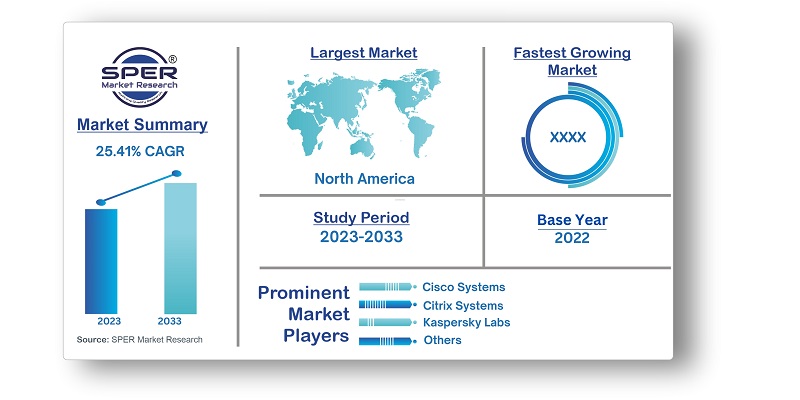
Mobile Threat Defence Market Growth, Size, Trends, Demand, Revenue, Share and Future Outlook
Mobile Threat Defence Market Size- By Component, By Operating System, By Deployment- Regional Outlook, Competitive Strategies and Segment Forecast to 2033
| Published: Sep-2023 | Report ID: IACT23161 | Pages: 1 - 234 | Formats*: |
| Category : Information & Communications Technology | |||
- Ivanti, a provider of cyber-security services, teamed up with Lookout in January 2023 to offer specialized cloud security solutions.
- VMware and the Lookout struck a collaboration deal in June 2022. Together, the two businesses unveiled "Workspace One," a thorough mobile threat detection tool.


| Report Metric | Details |
| Market size available for years | 2019-2033 |
| Base year considered | 2022 |
| Forecast period | 2023-2033 |
| Segments covered | By Component, By Operating System, By Deployment |
| Regions covered | North America, Asia-Pacific, Latin America, Middle East & Africa and Europe |
| Companies Covered | Cisco Systems, SAP, Broadcom, Inc., Citrix Systems, Kaspersky Labs, Ivanti, Micro Focus, SolarWinds, Matrix42, Sophos, Blackberry, and Esper |
- Enterprises and Businesses
- Government and Public Sector
- IT and Security Professionals
- Mobile Device Management (MDM) Providers
- Security Researchers and Analysts
- Individual Consumers
| By Component: |
|
| By Operating System: |
|
| By Deployment: |
|
- Global Mobile Threat Defence Market Size (FY’2023-FY’2033)
- Overview of Global Mobile Threat Defense Market
- Segmentation of Global Mobile Threat Defence Market By Component (Software, Service)
- Segmentation of Global Mobile Threat Defense Market By Operating System (Android, IOS, Windows, others)
- Segmentation of Global Mobile Threat Defence Market By Deployment (Cloud, On-Premise)
- Statistical Snap of Global Mobile Threat Defence Market
- Expansion Analysis of Global Mobile Threat Defense Market
- Problems and Obstacles in Global Mobile Threat Defence Market
- Competitive Landscape in the Global Mobile Threat Defence Market
- Impact of COVID-19 and Demonetization on Global Mobile Threat Defence Market
- Details on Current Investment in Global Mobile Threat Defence Market
- Competitive Analysis of Global Mobile Threat Defence Market
- Prominent Players in the Global Mobile Threat Defense Market
- SWOT Analysis of Global Mobile Threat Defence Market
- Global Mobile Threat Defence Market Future Outlook and Projections (FY’2023-FY’2033)
- Recommendations from Analyst
1.1. Scope of the report1.2. Market segment analysis
2.1. Research data source2.1.1. Secondary Data2.1.2. Primary Data2.1.3. SPER’s internal database2.1.4. Premium insight from KOL’s2.2. Market size estimation2.2.1. Top-down and Bottom-up approach2.3. Data triangulation
4.1. Driver, Restraint, Opportunity and Challenges analysis4.1.1. Drivers4.1.2. Restraints4.1.3. Opportunities4.1.4. Challenges4.2. COVID-19 Impacts of the Global Mobile Threat Defence Market
5.1. SWOT Analysis5.1.1. Strengths5.1.2. Weaknesses5.1.3. Opportunities5.1.4. Threats5.2. PESTEL Analysis5.2.1. Political Landscape5.2.2. Economic Landscape5.2.3. Social Landscape5.2.4. Technological Landscape5.2.5. Environmental Landscape5.2.6. Legal Landscape5.3. PORTER’s Five Forces5.3.1. Bargaining power of suppliers5.3.2. Bargaining power of buyers5.3.3. Threat of Substitute5.3.4. Threat of new entrant5.3.5. Competitive rivalry5.4. Heat Map Analysis
6.1. Global Mobile Threat Defence Market Manufacturing Base Distribution, Sales Area, Product Type6.2. Mergers & Acquisitions, Partnerships, Product Launch, and Collaboration in Global Mobile Threat Defence Market
7.1. Global Mobile Threat Defence Market Value Share and Forecast, By Component, 2023-20337.2. Software7.3. Service
8.1. Global Mobile Threat Defence Market Value Share and Forecast, By Operating System, 2023-20338.2. Android8.3. IOS8.4. Windows8.5. Others
9.1. Global Mobile Threat Defence Market Value Share and Forecast, By Deployment, 2023-20339.2. Cloud9.3. On-Premise
10.1. Global Mobile Threat Defence Market Size and Market Share
11.1. Global Mobile Threat Defence Market Size and Market Share By Component (2019-2026)11.2. Global Mobile Threat Defence Market Size and Market Share By Component (2027-2033)
12.1. Global Mobile Threat Defence Market Size and Market Share By Operating (2019-2026)12.2. Global Mobile Threat Defence Market Size and Market Share By Operating System (2027-2033)
13.1. Global Mobile Threat Defence Market Size and Market Share By Deployment (2019-2026)13.2. Global Mobile Threat Defence Market Size and Market Share By Deployment (2027-2033)
14.1. Global Mobile Threat Defence Market Size and Market Share By Region (2019-2026)14.2. Global Mobile Threat Defence Market Size and Market Share By Region (2027-2033)14.3. Asia-Pacific14.3.1. Australia14.3.2. China14.3.3. India14.3.4. Japan14.3.5. South Korea14.3.6. Rest of Asia-Pacific14.4. Europe14.4.1. France14.4.2. Germany14.4.3. Italy14.4.4. Spain14.4.5. United Kingdom14.4.6. Rest of Europe14.5. Middle East and Africa14.5.1. Kingdom of Saudi Arabia14.5.2. United Arab Emirates14.5.3. Rest of Middle East & Africa14.6. North America14.6.1. Canada14.6.2. Mexico14.6.3. United States14.7. Latin America14.7.1. Argentina14.7.2. Brazil14.7.3. Rest of Latin America
15.1. Blackberry15.1.1. Company details15.1.2. Financial outlook15.1.3. Product summary15.1.4. Recent developments15.2. Broadcom, Inc.15.2.1. Company details15.2.2. Financial outlook15.2.3. Product summary15.2.4. Recent developments15.3. Cisco Systems15.3.1. Company details15.3.2. Financial outlook15.3.3. Product summary15.3.4. Recent developments15.4. Citrix Systems15.4.1. Company details15.4.2. Financial outlook15.4.3. Product summary15.4.4. Recent developments15.5. Esper15.5.1. Company details15.5.2. Financial outlook15.5.3. Product summary15.5.4. Recent developments15.6. Ivanti15.6.1. Company details15.6.2. Financial outlook15.6.3. Product summary15.6.4. Recent developments15.7. Kaspersky Labs15.7.1. Company details15.7.2. Financial outlook15.7.3. Product summary15.7.4. Recent developments15.8. Matrix4215.8.1. Company details15.8.2. Financial outlook15.8.3. Product summary15.8.4. Recent developments15.9. Micro Focus15.9.1. Company details15.9.2. Financial outlook15.9.3. Product summary15.9.4. Recent developments15.10. SAP15.10.1. Company details15.10.2. Financial outlook15.10.3. Product summary15.10.4. Recent developments15.11. SolarWinds15.11.1. Company details15.11.2. Financial outlook15.11.3. Product summary15.11.4. Recent developments15.12. Others
SPER Market Research’s methodology uses great emphasis on primary research to ensure that the market intelligence insights are up to date, reliable and accurate. Primary interviews are done with players involved in each phase of a supply chain to analyze the market forecasting. The secondary research method is used to help you fully understand how the future markets and the spending patterns look likes.
The report is based on in-depth qualitative and quantitative analysis of the Product Market. The quantitative analysis involves the application of various projection and sampling techniques. The qualitative analysis involves primary interviews, surveys, and vendor briefings. The data gathered as a result of these processes are validated through experts opinion. Our research methodology entails an ideal mixture of primary and secondary initiatives.



Frequently Asked Questions About This Report
PLACE AN ORDER
Year End Discount
Sample Report
Pre-Purchase Inquiry
NEED CUSTOMIZATION?
Request CustomizationCALL OR EMAIL US
100% Secure Payment






Related Reports
Our Global Clients
Our data-driven insights have influenced the strategy of 200+ reputed companies across the globe.




















